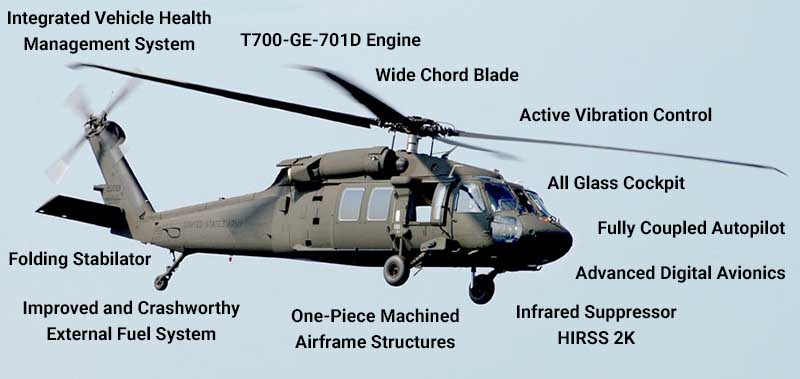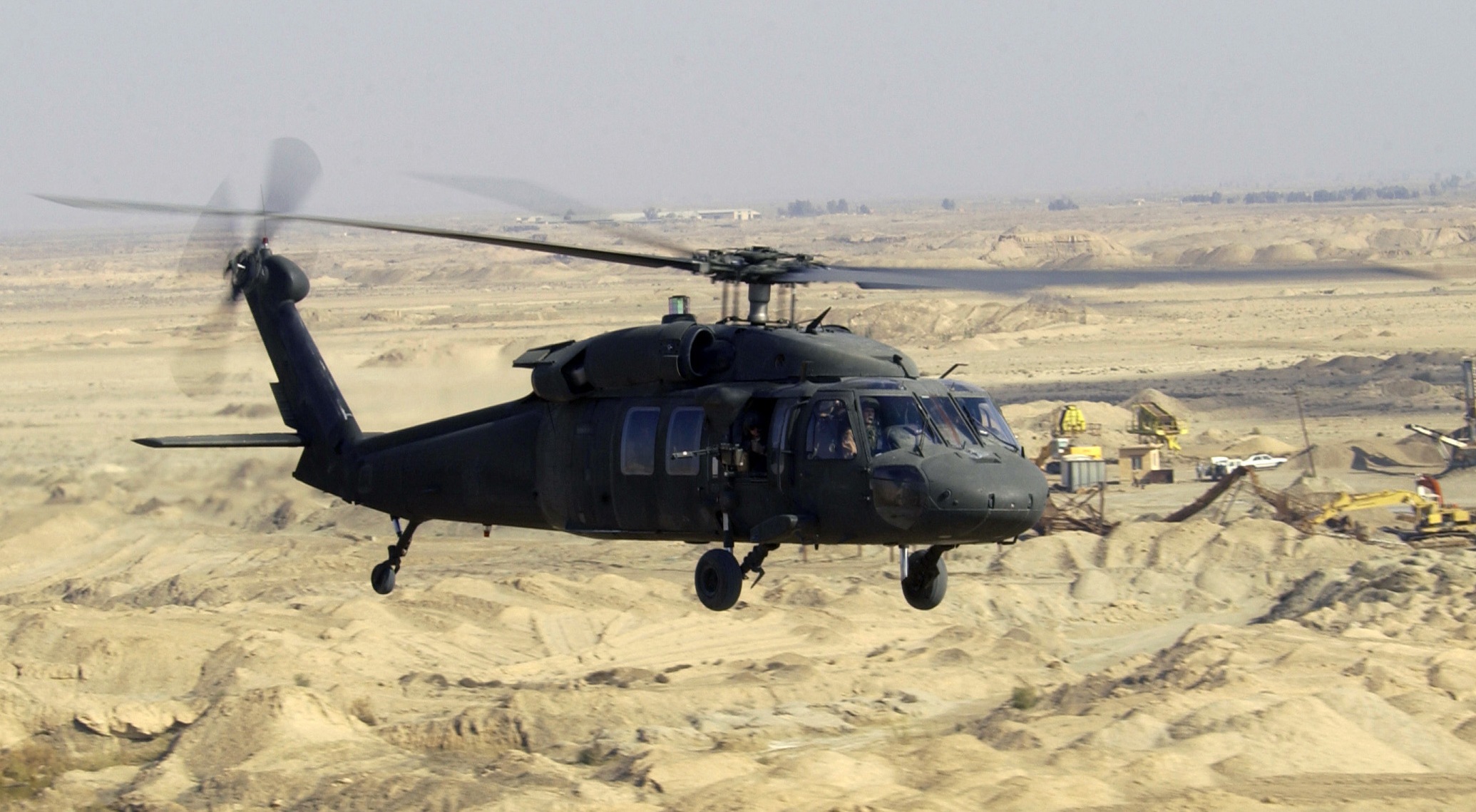The Relevance of the UH 60 in Military Workflow and Disaster Relief Efforts
The Relevance of the UH 60 in Military Workflow and Disaster Relief Efforts
Blog Article
UH-60: Advancements in Modern Helicopter Style
The UH-60 helicopter stands as a criteria in contemporary air travel, showcasing significant innovations in style and modern technology that provide to the evolving demands of military procedures. As we check out the evolution and key technologies of the UH-60, it comes to be important to consider just how these growths affect not just current applications however also the future landscape of helicopter layout.

Evolution of the UH-60
The development of the UH-60 Black Hawk helicopter stands for a considerable landmark in aerospace design and army aviation. Presented in the late 1970s, the UH-60 was designed by Sikorsky Airplane to meet the USA Army's demand for a flexible utility helicopter efficient in doing a variety of objectives. Its style emphasized rate, sturdiness, and ability to move, setting brand-new standards for functional performance.
The UH-60 features an unique four-blade blades system, which enhances lift and stability, permitting it to run effectively in varied environments. Its airframe is built from innovative composite products, adding to a reduction in weight while preserving structural integrity. The helicopter's design also includes enhanced aerodynamics, which improves gas performance and increases range.
Throughout the years, the Black Hawk has gone through several upgrades to enhance its capabilities, including boosted engines, progressed flight control systems, and modular systems for simple maintenance and versatility. The helicopter's capacity to carry out goals ranging from troop transport to medical emptying has solidified its role as a foundation of U.S. military operations. The UH-60 Black Hawk stays a prime instance of how advancement in helicopter style can dramatically affect armed forces effectiveness and functional versatility.
Advanced Avionics Systems
Advancements in avionics systems have transformed the capacities of contemporary helicopters like the UH-60 Black Hawk, improving functional performance and situational awareness (UH 60). The integration of sophisticated avionics enables boosted interaction, navigating, and trip management, making the UH-60 a lot more functional in varied objective accounts
One of the vital features is the innovative digital cabin, which utilizes multifunction screens that give real-time information, ensuring pilots have instant access to vital flight information. This streamlining of information reduces pilot workload and improves decision-making processes throughout complicated operations. Additionally, the incorporation of GPS and inertial navigating systems enables exact positioning and path preparation, enhancing objective implementation in tough settings.
In addition, progressed avionics systems improve interaction capacities with secure data web links and voice interaction systems, allowing seamless control with ground pressures and other aircraft. The assimilation of automated trip control systems further adds to boosted stability and control, especially in damaging weather condition conditions or during low-altitude maneuvers.
Engine and Efficiency Enhancements
Engine performance in modern helicopters has actually taken a substantial leap ahead, driven by innovations that enhance power, dependability, and effectiveness. At the leading edge of these developments is the adoption of even more effective turboshaft engines, particularly those using advanced materials and modern technologies that enable greater temperature resistances and boosted drive capabilities. The UH-60 Black Hawk, for example, uses the T700-GE-701C engine, which includes a dual-channel, full-authority digital engine control system. This system boosts efficiency while maximizing fuel consumption and lowering maintenance demands.
Additionally, the combination of engine health monitoring systems permits real-time diagnostics and predictive upkeep, significantly improving functional dependability. These systems not just sharp crews to possible problems prior to they become critical however also help with more reliable upkeep scheduling, thus decreasing downtime.

Materials and Structural Innovations
Current growths in products and structural design have actually revolutionized modern-day helicopter building, boosting both efficiency and resilience. The introduction of innovative composite products, such as carbon fiber strengthened polymers, has actually considerably lowered weight while maintaining architectural integrity. This change not just enhances fuel effectiveness however likewise boosts payload ability, permitting helicopters like the UH-60 to perform even more varied missions.
Furthermore, innovations in aluminum alloys and titanium components have actually added to improved resistance to rust and tiredness, expanding the lifespan of crucial airframe components. The tactical usage of these materials has actually led to a decrease in upkeep requirements and enhanced general functional preparedness.

Furthermore, the assimilation of computer-aided design (CAD) and additive manufacturing modern technologies has actually allowed a lot more lightweight structures and intricate geometries, optimizing see this site the wind resistant efficiency of helicopter designs. These improvements promote rapid prototyping and manufacturing, permitting suppliers to respond swiftly to advancing objective requirements.
Safety And Security and Survivability Features
Safety and security and survivability functions in modern-day helicopter design have come to be extremely important, reflecting the boosting demands for goal performance in difficult settings. The UH-60 Black Hawk, a remarkable example, incorporates advanced innovations to improve crew and passenger protection. One of one official source of the most important advancements is the consolidation of crashworthy fuel systems made to reduce the danger of fire throughout influence. In addition, the airframe is built with strengthened products that absorb and dissipate power, further securing passengers in case of a collision.
The helicopter additionally utilizes a ballistic security system, which consists of armored team seats and essential systems securing, lowering susceptability to tiny arms fire and shrapnel. Boosted situational understanding is achieved through innovative avionics and sensing unit technologies, allowing pilots to discover and avoid risks properly.
Furthermore, the assimilation of redundancy in critical systems-- such as dual engines and multiple trip control networks-- guarantees ongoing operation also if one system falls short. The UH-60 is outfitted with innovative emergency situation flotation protection gadgets, improving survivability in water landings. Collectively, these functions not just improve the safety of workers however also boost mission success rates in hostile environments, showing the dedication to excellence in helicopter layout.
Conclusion
The UH-60 helicopter represents a considerable development in modern aviation modern technology, integrating cutting-edge products, advanced avionics, and durable safety and security features. In general, the UH-60 offers as a benchmark for future advancements in helicopter style, symbolizing resilience and flexibility in contemporary military operations.
The UH-60 helicopter stands as a standard in modern air travel, showcasing substantial developments in design and modern technology that provide to the advancing demands of army procedures. As we discover the development and vital advancements of the UH-60, it ends up being vital to take into consideration how these advancements influence not just present applications yet also the future landscape of helicopter style.
Presented in the late 1970s, the UH-60 was developed by Sikorsky Airplane to satisfy the United States Army's requirement for a flexible energy helicopter capable of doing a variety of goals. The UH-60 Black Hawk remains these details a prime instance of just how development in helicopter layout can considerably influence military efficiency and operational versatility.
Generally, the UH-60 serves as a standard for future developments in helicopter design, symbolizing resilience and adaptability in modern armed forces operations.
Report this page